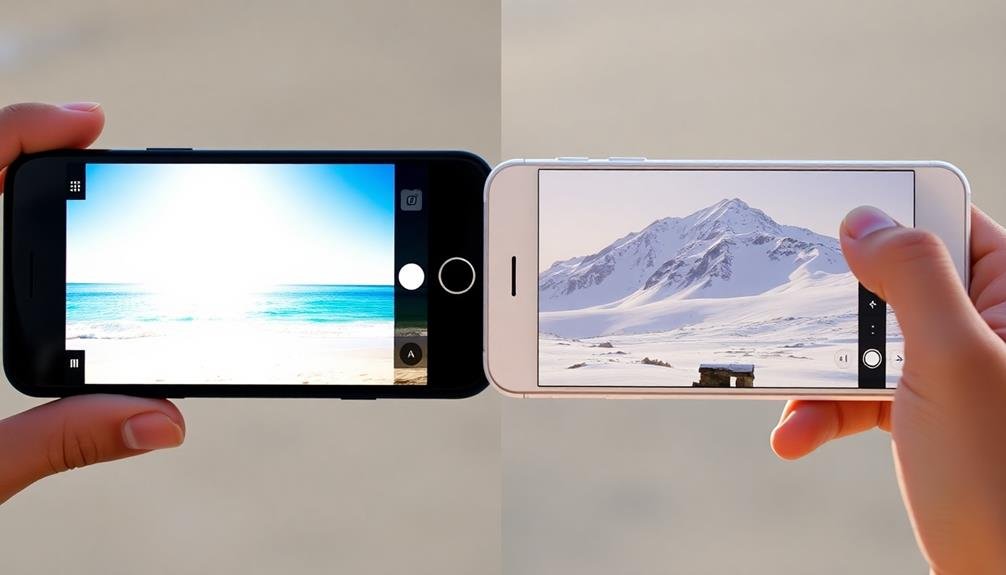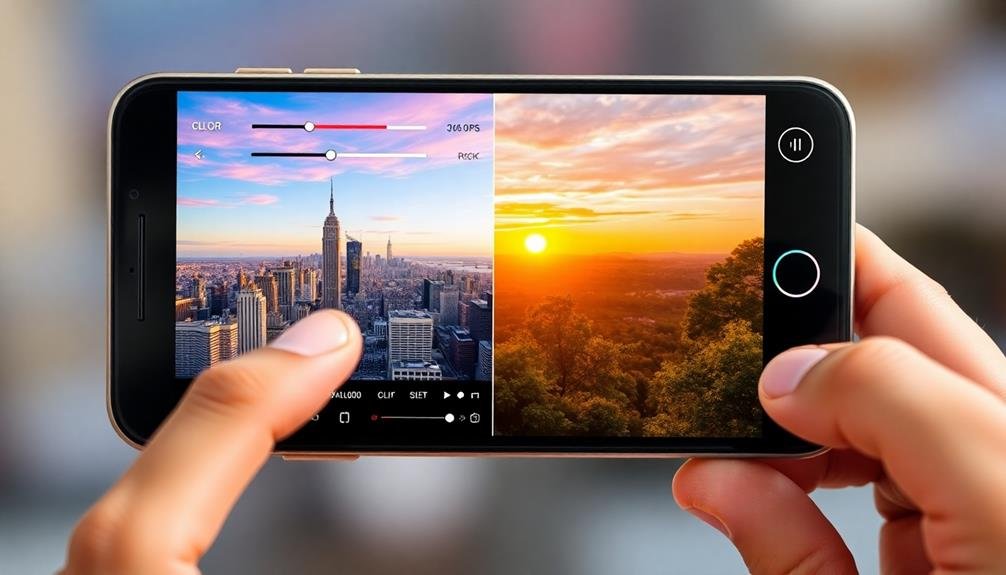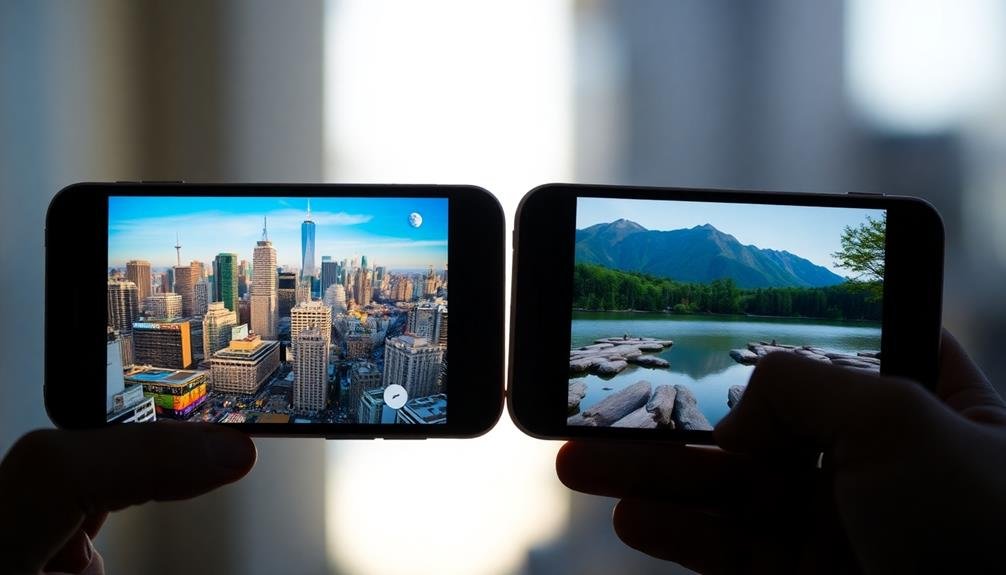Juxtaposition in smartphone photography is a technique where you place contrasting elements side by side in a single frame to create visual interest. You'll capture elements that differ in size, color, texture, or concept to highlight their differences and evoke emotions or tell stories. It's commonly found in urban settings, but you can spot opportunities anywhere by training your eye to notice contrasts. Your smartphone's features, like HDR mode, can enhance these differences. By mastering juxtaposition, you'll transform ordinary scenes into intriguing images that provoke thought and engage viewers. Dive deeper to reveal the full potential of this powerful compositional tool in your smartphone photography.
Definition of Juxtaposition

Juxtaposition, a powerful compositional technique in photography, refers to the deliberate placement of contrasting elements side by side within a single frame. When you use juxtaposition in your smartphone photos, you're creating visual tension and interest by highlighting the differences between two or more subjects. This technique can evoke emotions, tell a story, or convey a message more effectively than showcasing a single subject alone.
In smartphone photography, you'll often find juxtaposition in urban settings, where old and new architecture coexist, or in scenes that contrast nature with man-made structures. You can also create juxtaposition through color, size, texture, or even conceptual ideas. For example, you might capture a small child standing next to a towering skyscraper, or a vibrant flower growing through a crack in the concrete.
To effectively use juxtaposition, you'll need to train your eye to spot these contrasting elements in your everyday surroundings. It's about finding unexpected connections and relationships between different subjects.
Types of Juxtaposition

When exploring juxtaposition in smartphone photography, you'll encounter several key types to enhance your images.
You can create striking contrasts by focusing on size and scale differences, such as capturing a tiny object next to something massive.
Additionally, you'll find opportunities in color and texture variations, as well as juxtaposing old and new elements within a single frame.
Size and Scale Contrast
One of the most striking types of juxtaposition in smartphone photography is size and scale contrast. This technique involves placing objects of vastly different sizes side by side to create a visually compelling image. You'll often see this used to emphasize the grandeur of large subjects or the intricate details of small ones.
To effectively use size and scale contrast in your smartphone photography:
- Look for opportunities to pair small and large objects in the same frame, such as a person next to a skyscraper or a flower beside a mountain.
- Experiment with perspective to exaggerate size differences. Get close to small objects or use a low angle to make large subjects appear even more imposing.
- Pay attention to the balance in your composition. Confirm that both the small and large elements are clearly visible and contribute to the overall story of your image.
When you're out shooting, keep an eye out for unexpected size contrasts in your environment. You might find a tiny insect on a massive leaf or a miniature toy car next to a real vehicle.
These juxtapositions can create powerful visual narratives and evoke emotions in your viewers.
Color and Texture Differences
Another powerful technique in smartphone photography is the use of color and texture differences to create striking juxtapositions. You can capture eye-catching images by placing contrasting colors side by side, such as a vibrant red object against a deep blue background. This color contrast draws attention and creates visual interest in your composition.
Texture differences also offer opportunities for juxtaposition. Try combining smooth and rough surfaces, like a glossy apple next to a weathered wooden table. You can enhance these contrasts by adjusting your smartphone's focus and lighting settings to emphasize the textural differences.
Don't limit yourself to single elements; consider combining multiple color and texture contrasts in one frame. For instance, capture a scene with a soft, pastel-colored flower against a rugged, dark-colored rock face. This creates a multi-layered juxtaposition that engages viewers on different levels.
Experiment with your smartphone's various modes and filters to further accentuate these differences. Use HDR mode to bring out subtle color variations or apply selective focus to highlight textural details.
Old Versus New
Juxtaposing old and new elements in smartphone photography can create compelling visual narratives. This contrast highlights the passage of time and the evolution of technology, culture, and society. When capturing these scenes, look for opportunities where traditional and modern elements coexist in the same frame.
You might find this juxtaposition in urban environments where historic buildings stand alongside sleek skyscrapers. Alternatively, focus on everyday objects, such as an antique typewriter next to a cutting-edge smartphone. The key is to compose your shot in a way that emphasizes the stark differences between the old and new elements.
To enhance your old versus new juxtaposition photos:
- Use leading lines to draw attention to both elements
- Experiment with different angles to create a balanced composition
- Play with lighting to accentuate textures and details of both subjects
Remember that successful juxtaposition isn't just about placing two contrasting objects in the same frame. It's about telling a story through visual comparison.
Identifying Juxtaposition Opportunities

Spotting juxtaposition opportunities starts with training your eye to notice contrasting elements in everyday scenes.
You'll find rich possibilities in urban environments, where modern architecture often clashes with historical buildings or nature struggles against concrete.
Don't overlook the interplay between natural and man-made elements, as these can create striking visual narratives in your smartphone photos.
Contrasting Elements in Scenes
The keen eye of a smartphone photographer can transform ordinary scenes into enchanting juxtapositions. As you explore your surroundings, look for contrasting elements that create visual tension or tell a compelling story. These contrasts can be found in various aspects of a scene, including size, color, texture, or even conceptual differences.
To capture effective juxtapositions, consider these key elements:
- Scale contrasts: Seek out scenes where objects of vastly different sizes are placed near each other, like a tiny flower growing next to a towering skyscraper.
- Color contrasts: Look for bold color combinations that clash or complement each other in unexpected ways, such as a vibrant red umbrella against a stark gray cityscape.
- Thematic contrasts: Identify situations where opposing ideas or concepts are visually represented, like a modern smartphone user sitting next to an antique rotary phone.
When you spot these contrasting elements, frame your shot to emphasize the juxtaposition. Use your smartphone's grid feature to align the contrasting elements strategically within the frame.
Don't be afraid to experiment with different angles and perspectives to highlight the contrast and create a visually striking image that tells a unique story.
Urban vs. Natural Settings
Concrete jungles and verdant landscapes offer a wealth of juxtaposition opportunities for smartphone photographers.
You'll find striking contrasts between the rigid lines of skyscrapers and the organic shapes of trees, or between bustling city streets and serene natural paths. Look for places where urban and natural elements intersect, such as parks within cities or abandoned buildings reclaimed by nature.
Capture the interplay of artificial and natural light sources. Streetlamps illuminating foliage or sunlight reflecting off glass buildings can create compelling visual contrasts.
Pay attention to textures, juxtaposing smooth concrete against rough bark or sleek metal against flowing water.
Consider the human element in your compositions. A person in business attire standing amidst a forest or hikers traversing city sidewalks can emphasize the urban-nature divide.
Use leading lines to guide the viewer's eye between contrasting elements, like a paved road leading into a dense forest.
Experiment with different angles and perspectives to heighten the sense of juxtaposition. A low angle shot can make skyscrapers loom over nearby trees, while a bird's-eye view might reveal pockets of greenery amid a sea of buildings.
Framing for Juxtaposition

When framing for juxtaposition in smartphone photography, carefully consider the composition of your shot to highlight contrasting elements. Look for visual opposites within your frame, such as old and new, light and dark, or big and small. Position these elements strategically to create a compelling narrative or evoke a specific emotion in your viewers.
To effectively frame for juxtaposition, you'll want to:
- Use the rule of thirds to place contrasting elements at intersecting points
- Experiment with different angles to emphasize the relationship between subjects
- Utilize leading lines to guide the viewer's eye between juxtaposed elements
Don't be afraid to get creative with your framing. Sometimes, unexpected combinations can yield the most striking results. Try using reflections, shadows, or even the smartphone's wide-angle lens to capture unique juxtapositions.
Remember, the goal is to create visual tension that tells a story or challenges perceptions.
As you practice framing for juxtaposition, you'll develop a keen eye for spotting contrasts in everyday scenes. This skill will elevate your smartphone photography, allowing you to capture thought-provoking images that resonate with viewers on a deeper level.
Editing Techniques for Juxtaposition

Smartphone editing tools can greatly enhance juxtaposition in your photos. When editing for juxtaposition, focus on accentuating the contrasting elements you've captured.
Start by adjusting the exposure and contrast to make the differences more pronounced. You can use selective editing to brighten one area while darkening another, emphasizing the visual disparity.
Color manipulation is another powerful technique. Boost the saturation of contrasting colors or use color grading to create a stark difference between elements. You might even consider desaturating part of the image while leaving another area in full color.
Cropping can help tighten the composition and bring juxtaposed elements closer together, making their relationship more apparent. Don't be afraid to experiment with unconventional crops to highlight the contrast.
Consider using vignettes or graduated filters to direct attention to specific areas of juxtaposition. These tools can subtly guide the viewer's eye to where you want it to focus.
Lastly, play with sharpness and blur. Selectively sharpening one element while softening another can create a striking juxtaposition of focus, adding depth and interest to your smartphone photographs.
Lighting and Contrast

Lighting and contrast play essential roles in creating effective juxtaposition in smartphone photography. By manipulating these elements, you can enhance the visual impact of your juxtaposed subjects and draw attention to their differences or similarities.
When capturing juxtaposition, consider how light and shadow interact with your subjects to create depth and dimensionality.
To effectively use lighting and contrast in juxtaposition:
- Experiment with high-contrast scenarios: Seek out scenes with stark differences in light and dark areas, such as a brightly lit object against a shadowy background.
- Utilize natural light sources: Position your subjects near windows or in outdoor settings to take advantage of directional lighting that can emphasize texture and form.
- Play with silhouettes: Create dramatic juxtapositions by photographing subjects backlit against a bright sky or light source, emphasizing their shapes and outlines.
Don't be afraid to adjust your smartphone's exposure settings to achieve the desired contrast. You can also use HDR mode to capture a wider range of tones in high-contrast scenes.
Color Theory in Juxtaposition

Color theory is a powerful tool in creating compelling juxtapositions in smartphone photography. By understanding how different colors interact, you can create striking contrasts that draw the viewer's eye and convey powerful messages. When composing your shots, consider using complementary colors—those opposite each other on the color wheel—to create dynamic tension. For example, pairing blue and orange or red and green can produce visually arresting images.
You can also use color temperature to your advantage. Juxtaposing warm and cool tones can create a sense of depth and dimension in your photographs. Don't be afraid to experiment with monochromatic color schemes or analogous colors for a more subtle approach to juxtaposition.
Here's a quick reference guide for color combinations in juxtaposition:
| Color Pairing | Effect | Example Subjects |
|---|---|---|
| Red & Green | Vibrant | Nature & Urban |
| Blue & Orange | Dynamic | Sky & Architecture |
| Purple & Yellow | Regal | Flowers & Sunsets |
| Black & White | Classic | Shadows & Highlights |
| Warm & Cool | Depth | Candlelight & Daylight |
Storytelling Through Juxtaposition

Crafting a narrative through visual contrast is at the heart of storytelling with juxtaposition in smartphone photography. You'll find that by placing contrasting elements side by side, you can create compelling images that convey powerful messages.
Whether it's old versus new, rich versus poor, or nature versus urban, juxtaposition allows you to tell a story without words.
To effectively use juxtaposition for storytelling in your smartphone photos:
- Identify a theme or message you want to convey.
- Look for contrasting elements that represent your theme.
- Compose your shot to highlight the contrast between these elements.
When you're out shooting, keep an eye out for unexpected pairings that can spark curiosity or provoke thought. You might capture a modern skyscraper looming over a historic building, or a luxury car parked next to a run-down bicycle.
These contrasts can speak volumes about societal changes, economic disparities, or the passage of time. Remember, the most impactful juxtapositions often emerge from everyday scenes, so always be ready to capture those fleeting moments that tell a story through contrast.
Common Mistakes to Avoid

When it comes to juxtaposition in smartphone photography, even seasoned photographers can fall into common traps. One frequent mistake is forcing contrasts that don't naturally exist, resulting in images that feel contrived or artificial. You'll want to avoid this by seeking genuine, organic juxtapositions in your surroundings.
Another error is overcomplicating the composition. While juxtaposition thrives on contrast, cluttering your frame with too many elements can dilute the impact. Stick to clear, simple comparisons that viewers can easily grasp.
Don't forget about lighting. Uneven illumination can undermine your juxtaposition, making one element more prominent than the other. Ascertain both subjects are well-lit to maintain balance.
Relying too heavily on post-processing is also problematic. While editing can enhance contrasts, it shouldn't create them entirely. The core juxtaposition should exist in the original shot.
Lastly, avoid clichéd juxtapositions that have been overused. Instead of replicating common contrasts, challenge yourself to find unique, thought-provoking comparisons that'll captivate your audience and elevate your smartphone photography to new heights.
Frequently Asked Questions
Can Juxtaposition Be Used Effectively in Black and White Smartphone Photography?
Yes, you can use juxtaposition effectively in black and white smartphone photography. It'll emphasize contrasts between subjects, creating striking visual impact. You'll highlight differences in shapes, textures, and tones, making your compositions more powerful and engaging.
Are There Specific Apps That Enhance Juxtaposition in Smartphone Photos?
You'll find several apps that can enhance juxtaposition in your smartphone photos. Try VSCO, Snapseed, or PicsArt for powerful editing tools. These apps offer filters, layering, and composition guides to help you create striking contrasts in your images.
How Can I Practice Juxtaposition Techniques Without Leaving My Home?
You can practice juxtaposition at home by arranging contrasting objects in your space. Try pairing old and new items, different textures, or opposing colors. Use windows, mirrors, and reflections to create interesting compositions within your living environment.
Does Juxtaposition Work Well With Portrait Mode on Smartphones?
Yes, juxtaposition works well with portrait mode. You'll find it's an excellent tool for creating contrast between your subject and the background. Try pairing unexpected elements to enhance the visual impact of your portraits.
Can Juxtaposition Be Overdone or Overused in Smartphone Photography?
Yes, you can overdo juxtaposition in your smartphone photos. If you're constantly forcing contrasts, it'll lose its impact. Use it sparingly and purposefully to create meaningful compositions. Don't let it overshadow your subject or message.
In Summary
You've now got the tools to master juxtaposition in smartphone photography. Remember, it's all about creating visual contrast and telling compelling stories through your images. As you practice, you'll develop an eye for spotting unique juxtaposition opportunities in everyday scenes. Don't be afraid to experiment with different types, framing techniques, and editing styles. With time and effort, you'll be capturing thought-provoking juxtaposed images that'll make your viewers pause and reflect.





Leave a Reply